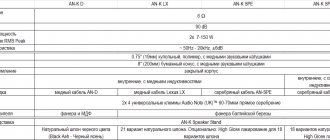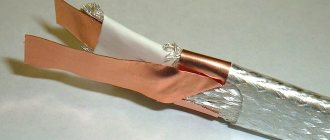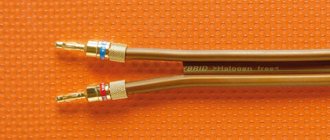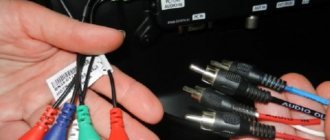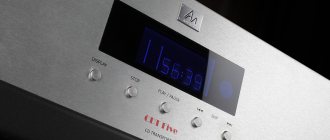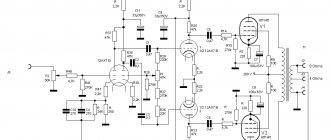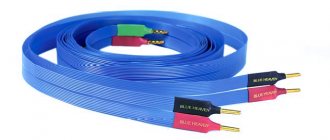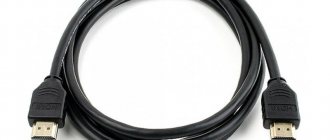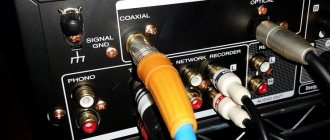Interconnect cables
| AN-A | Entry-level interconnect cable made of copper Litz wire. |
| AN-C | Interconnect cable made of copper Litz wire. |
| AN-S | Standard silver interconnect cable. |
| AN-V | Silver interconnect cable made of 19 silver cores with a diameter of 0.09 mm, with an insulated copper screen. |
| AN-Vx | Silver interconnect cable made of 31 silver cores with a diameter of 0.09 mm, with an insulated copper screen. |
Speaker cables
| AN-D | Entry-level speaker cable. In our opinion, few cable manufacturers can compete with AN-D in terms of price/quality ratio. |
| AN-B | High-quality universal copper speaker cable that works perfectly with both powerful transistor amplifiers and tube amplifiers. |
| AN-L | 99.9999% pure Litz copper speaker cable with grounded braided copper shield. |
| AN-SP | The first model in a series of silver speaker cables. |
| AN-SPa | 13-core silver litz wire speaker cable. |
| AN-SPe | 19-core silver litz wire speaker cable. |
| AN-SPx | 31-core silver litz wire speaker cable. |
| AN-SOGON LX | 96-conductor silver litz wire speaker cable (see below). |
SOGON's 80-core silver litz wire with four silver conductors allows bi-wire connectivity with a single cable. The SOGON design is similar to earlier Audio Note cables, but significant (and expensive) changes have been made. SOGON series cables are the most expensive Audio Note cables. On the other hand, when it comes to music reproduction, they are extremely convincing.
Interconnect cables
| vendor code | Model | Description |
| AN-CABLE-100 | AN-A | Symmetrical Litz copper interconnect cable (99.99% purity) |
| Cutting | Silver plated RCA connectors AN-GP-AG | |
| AN-CABLE-150 | AN-C | Symmetrical Litz copper interconnect cable (99.99% purity) |
| Cutting | Gold plated RCA AN-GP connectors | |
| AN-CABLE 1150 | LEXUS | Copper version of SOGON interconnect cable |
| Cutting | Silver plated RCA connectors AN-GP-AG | |
| AN-CABLE-200 | AN-S | Symmetrical 15-core Litz copper interconnect cable (99.99% purity) |
| Cutting | Silver plated RCA connectors AN-GP-AG | |
| AN-CABLE-250 | AN-V | Symmetrical 19-core interconnect cable made of silver litz wire (99.99% purity), copper shield |
| Cutting | Silver plated RCA connectors AN-GP-AG | |
| AN-CABLE-300 | AN-Vx | Symmetrical 31-core interconnect cable made of silver litz wire (99.99% purity), copper shield |
| Cutting | Silver plated RCA connectors AN-GP-AG | |
| AN-CABLE-1300 | SOGON | Symmetrical 50-core interconnect cable made of silver litz wire (99.99% purity), copper shield |
| Cutting | Silver plated RCA AN-P connectors |
By special order, other cutting options with XLR, LEMO, Fischer, BNC, etc. connectors are also possible. All Audio Note interconnects are designed for maximum signal transfer with minimal loss across the entire audio spectrum. All Audio Note interconnect cables transmit both analog and digital signals equally well. All Audio Note interconnect cables are quite flexible (except SOGON) and can be used over long distances.
Mounting wire for tonearms
| Model | Description |
| AN-AI | Internal tonearm wire made of 3 braided wires 0.05 mm. Available in 4 colors: blue, green, red, silver. |
Speaker cables
| vendor code | Model | Description |
| AN-CABLE-500R AN-CABLE-500B | AN-D Red AN-D Black | Single conductor made of 99.99% pure copper, color – red or black. |
| As above | AN-D | Two conductors made of 99.99% pure copper, color – red and black, for monophonic connection. |
| As above | AN-D | Four conductors made of 99.99% pure copper, color – red and black, for stereo connection. |
| Cutting | Silver-plated Audio Note proprietary banana plugs (AN-BP/AG) on both ends. | |
| AN-CABLE-550 | AN-Ba | Single shielded copper conductor 99.99% purity, mono. |
| As above | AN-Ba | Two shielded double conductors made of 99.99% pure copper, stereo. |
| Cutting | Silver-plated Audio Note proprietary banana (AN-BP/AG) or spade (AN-SS) connectors. | |
| AN-CABLE-600A | AN-La | Single screened Litz copper conductor 99.99% pure, mono. |
| As above | AN-La | Two shielded dual conductors made of 99.99% pure Litz copper, stereo. |
| Cutting | Silver-plated Audio Note proprietary banana (AN-BP/AG) or spade (AN-SS) connectors. | |
| AN-CABLE-630 | LEXUS XL | Pure Litz copper single conductor, 4 inner conductors per core, copper version of SOGON cable. |
| As above | LEXUS XL | Double conductor, characteristics as above, for connection in mono or bi-wire mode. |
| As above | LEXUS XL | Four conductors for connection in stereo or bi-wire mode. Copper version of the AN-SPz/SOGON LX cable. |
| Cutting | Silver-plated Audio Note proprietary banana (AN-BP/AG) or spade (AN-SS) connectors. | |
| AN-CABLE-800 | AN-SPa | Audio Note Single 12-Conductor Silver Litz conductor 99.99% pure. |
| As above | AN-SPa | Dual 12-conductor Audio Note 99.99% pure silver Litz wire for monaural connection. |
| As above | AN-SPa | Four 15-core 99.99% pure silver Litz wires for stereo connection. |
| Cutting | Silver-plated Audio Note proprietary banana (AN-BP/AG) or spade (AN-SS) connectors. | |
| AN-CABLE-850 | AN-SPe | Audio Note Single 17 Core Silver Litz conductor 99.99% pure. |
| As above | AN-SPe | Two 17-conductor Audio Note 99.99% pure silver Litz wires for monaural connection. |
| As above | AN-SPe | Four 17-core Audio Note 99.99% pure silver Litz wires for stereo or bi-wire connection. |
| Cutting | Silver-plated Audio Note proprietary banana (AN-BP/AG) or spade (AN-SS) connectors. | |
| AN-CABLE-700 | AN-SPx | Audio Note Single 27 Conductor Silver Litz conductor 99.99% pure. |
| As above | AN-SPx | Two 27-conductor Audio Note 99.99% pure silver Litz wires for monaural connection. |
| As above | AN-SPx | Four 27-conductor Audio Note 99.99% pure silver Litz wires for stereo connection. |
| Cutting | Silver-plated Audio Note proprietary banana (AN-BP/AG) or spade (AN-SS) connectors. | |
| AN-CABLE-900.1 | SOGON LX | Single cable with 4 internal conductors per core, Audio Note 99.99% pure silver litz wire. |
| As above | SOGON LX | Dual cable with 4 internal conductors per core, Audio Note 99.99% pure silver litz wire. |
| SOGON LX | Four separate 40-strand Audio Note 99.99% pure silver litz wires, two different gauge conductors in one braid. | |
| Cutting | Silver-plated Audio Note proprietary banana (AN-BP/AG) or spade (AN-SS) connectors. |
All Audio Note speaker cables are marked with a plus (+) and minus (-) sign on the jacket.
Any configurations and lengths of single, mono, stereo, bi-wired or tri-wire cables are available. Please clearly indicate all requirements when ordering!
Buy on HiFi-Sale.com
Audio Note components, cables and speakers
If it occurs to anyone to rank the cult audio equipment of all time, then the Audio Note Ongaku amplifier has every chance of being in the top three. Its price has always shocked the uninitiated, but times are changing - not so long ago the company released a lightweight version of this legendary device.
Audio Note Jinro
- Rated output power per channel (8 ohms): 18 W
- Distortion factor at rated output power: 5%
- Frequency bandwidth (±1 dB): 20 - 20000 Hz
- Input sensitivity: 200mV RMS
- Signal to noise ratio: 75 dB
- Input impedance: 100 kOhm
- Dimensions: 300 x 660 x 280 mm
- Weight: 38.5 kg
- Price: 871,718 rub.
Created in 1989 by the founder of Audio Note, master Hiroyashi Kondo, the 34-kilogram single-cycle monster with a power of 2 x 27 W on directly heated 211 triodes made a real revolution in the minds of audiophiles. And the unrealistic (especially for that time) price, reaching up to $82,000 in some countries*, contributed to its transformation into a symbol of perfection, unattainable for mere mortals.
* Inflation does not stand still; Ongaku currently costs $120,000.
The Jinro model, released early last year, is positioned as a simplified and more affordable version of Ongaku. The brainchild of Andy Grove, chief engineer at Audio Note UK, it is made in the same form factor and uses the same output tubes, although the circuit has become noticeably more concise. Instead of four double triodes, only a pair are used for pre-amplification and drive - 5814 and 5687 (or 7044), respectively. The tubes themselves are selected so that their sound signatures complement each other. In Ongaku, the output tube grids were coupled to cathode followers, while in Jinro, the signal from the drivers is transmitted through a 1:1 transformer specially designed by Groove. This, in his opinion, gives an energetic, more modern sound. The anode rectifier has also been sequestered; now it has four 5R4WGB kenotrons instead of two.
SYSTEM
- CD player Audio Note CD3.1x V.2 (RUB 255,621)
- Transrotor Rondino Nero FMD vinyl player (RUB 466,200) with TR1200S tonearm (RUB 46,000), Audio Note IQ-1 heads (RUB 15,657) and Ortofon SPU Classic GM MKII (RUB 30,000)
- Phono stages Audio Note M2RIAA (RUB 135,373) and M3Phono (RUB 358,943)
- Integrated amplifier Audio Note Jinro (RUB 871,718)
- Speaker systems Audio Note AN-E SPe (RUB 250,234/pair)
- Cables: — interconnect Audio Note AN-VX 1.45 m (56,000 rub.)
- — acoustic Audio Note AN-SPX 12 m (RUB 318,000)
Let me remind you that in Ongaku the interstage capacitors were branded Silver in Oil, and the secondary output transformers were wound with wire made of pure Italian silver, and all internal wiring was made with it. At Jinro, silver has been replaced by copper throughout, which has reduced the cost by almost four times. The rest of the filling meets the requirements of the third level: Beyschlag resistors, copper-in-oil signal capacitors and electrolytic capacitors - Black Gate. The installation is carried out using a hinged method; no printed circuit boards are used. All assembly and soldering, of course, is done by hand.
The CD3.1xV2 is Audio Note's first CD player to feature a full-size "OTO" cabinet. It combines CDT One/II transport based on a modified Philips CD drive and DAC 1.1x/II Signature on Analogue Devices AD1865. There is no oversampling or digital filter in the path, and dual ECC88 triodes are used in the output stages. The components meet the requirements of the third level: tantalum resistors, copper foil capacitors in oil and the legendary Black Gate. The only digital outputs are coaxial S/PDIF. The device is available in black and silver versions.
As an alternative source, a Transrotor Rondino Nero FMD turntable with a TR1200S tonearm and an entry-level Audio Note IQ-1 head was used. This is a serious 40kg machine with a heavy acrylic platter, belt drive, a well-damped table and heavy record pressure. Many design solutions are borrowed from the more expensive Turbillon 07 FMD model. Installation of 9- and 12-inch tonearms is provided. Available in black, as well as an option more typical of early Transrotor models - a combination of transparent acrylic with mirror-polished aluminum.
Using the AN-E speaker as an example, sales managers can study comparative positioning. It comes in eleven variants with different drivers, internal wiring, terminals and even external crossovers. Depending on the configuration, the product may belong to level 2, 3, 4 or 5. Those with the HE (High Efficiency) index have a sensitivity of 98 dB, therefore they are recommended for working with low-power single-ended amplifiers, for example, Paladin and Vindicato.
In the AN-E version, which we will listen to, the internal wiring is made with a proprietary SPe silver cable, as reflected in the name. These are two-way systems with an inch silk tweeter and a low-frequency driver, the 8-inch diffuser of which is made of cellulose. For the right and left speakers, the heads are selected in pairs, and the filter elements are manually adjusted to match them. The volume of the case, which is quite large for a two-way speaker, and the bass-reflex design (port at the back) made it possible to lower the lower limit to 18 Hz (-6 dB). By the way, to increase linearity in the bass register and expand the sound stage, Audio Note experts strongly recommend placing speakers in the corners of the room. The maximum sound pressure that these supermonitors are capable of developing is about 108 dB.
I have repeatedly had to listen to Audio Note components, and at very different levels. They do not open up right away; it takes time to taste their sound. I’m not talking about warming up, that goes without saying, but about adapting perception, especially if before that you listened exclusively to transistor equipment with tight acoustics. At first, the sound seems unremarkable - neither the bass nor the dynamics produce a stunning effect. And they shouldn’t, because the point here is in more subtle matters. Take, for example, the sound of strings [1]. The timbres are calibrated with amazing precision, literally polished; in the orchestra, each instrument has its own unique character and vibrations. The impression of music is completely different; thanks to the easy and relaxed sound production, the technical aspect of playback remains beyond the scope of perception. I am quite skeptical about dividing the audience into music lovers and audiophiles, but this set is clearly for lovers of music, not sounds. Here you can appreciate the nuances and semantic accents of the performance, the accuracy of rhythm and the depth of pauses. In the most avant-garde and non-melodic exercises of Tom Waits [2], a certain sacred meaning was revealed, and the emotional component simply went off scale. Although from a technical point of view this disc was recorded frankly illiterately.
The sound stage is usually described in terms of “width, depth, localization”; in our case, it was either a smaller copy of a concert hall, or a space limited by the walls of the studio. I can’t note a particularly sharp focus, and it would contrast with the general mood of the system, which gives the listener the opportunity to appreciate the integrity of the sound picture without being distracted by individual fragments.
By the way, Andy Grove is a real biker, his arms are covered in tattoos, and he listens mainly to rock music. That's why he tried to get Jinro to deliver more energetically than Ongaku. It is not surprising that the character of the new amplifier is a bit like a two-stroke - with a sharp attack of the blow, filling of the lower register and the absence of laziness, initially inherent in the single-end. This was fully demonstrated at the acoustic concert of Nirvana [3], where Jinro, without losing sophistication and sophistication, showed real drive, with powerful bass and a bright, transparent top.
It turned out interesting with vinyl too - the bass became even deeper, there was an emphasis on the lower mids, which gave the vocals additional physicality. The scene gained depth, but overall became less detailed. The images became larger, a feeling of a light veil appeared, after which it was decided to replace the entry-level Audio Note IQ-1 head with an Ortofon SPU. The system responded instantly - solidity appeared in the sound, the top was noticeably cleared, and the presence of the equipment as such as an intermediary between the listener and the musicians was reduced to a minimum.
As we listened, we experimented a little with speaker cables. I must note that the described system reacted incredibly sensitively to their change; the difference was obvious. Copper gave the sound a rough, unkempt character, with an energetic presentation, but with blurred nuances. I liked this option more with rock music, but chamber jazz and classical seemed more adequate with a silver cable. It introduced strict order into the overall picture, clearly gave more information, especially in the upper range, the reproduction acquired smoothness and melodiousness, although compared to copper it seemed less interesting and playful.
MUSIC WE LISTENED TO
CD
- Abel: Six Symphonies, Dir. Adrian Shepperd. Chandos, 1998
- Tom Waits, "Real Gone". Jalma Music, 2004
- Nirvana, "Unplugged in New York". Geffen, 1994
- "20th Anniversary of Chesky Records". 2 CDs, Chesky Records, 2006
LP
- Cassandra Wilson, New Moon Daughter. Blunote, 1995
- Sly And The Family Stone, "Fresh". EPIC, 1973
- Deep Purple, "Fireball". Warner Bros, 1971
share
Tags: Audio NoteOrtofonTransrotorSystem approach

